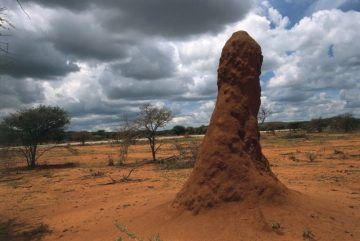Jennifer Ouellette in Ars Technica:
 Visit the African savannas in Zimbabwe or Namibia, and you might notice large, towering termite mounds dotted about the landscape—nature’s skyscrapers, if you will. And nature is quite the engineer: those mounds are self-cooling, self-ventilating, and self-draining. New 3D X-ray images have revealed that one of the secrets to this impressive efficiency is a vast network of micropores in the walls of the mounds, according to a recent paper in Science Advances.
Visit the African savannas in Zimbabwe or Namibia, and you might notice large, towering termite mounds dotted about the landscape—nature’s skyscrapers, if you will. And nature is quite the engineer: those mounds are self-cooling, self-ventilating, and self-draining. New 3D X-ray images have revealed that one of the secrets to this impressive efficiency is a vast network of micropores in the walls of the mounds, according to a recent paper in Science Advances.
Termite mounds, with their ingenious mechanisms for climate control, have been providing inspiration for architectural design for at least the last 20 years, most notably when Zimbabwean architect Mick Pearce based his design for the Eastgate Center in his nation’s capital of Harare on the termite mounds he observed in the region. He wanted to move away from the big glass block designs previously favored for office buildings and wanted his design to be heated and cooled almost entirely by natural means. The Eastgate Center is the country’s largest commercial and shopping complex, and yet it uses less than 10 percent of the energy consumed by a conventional building of its size, because there is no central air conditioning and only a minimal heating system.
The termite mounds are basically fungus farms, since fungus is the termites’ primary food source. Conditions have to be just right in order for fungus to flourish. So the termites must maintain a constant temperature of 87°F in an environment where the outdoor temperatures range from 35°F at night to 104°F during the day.
More here.
